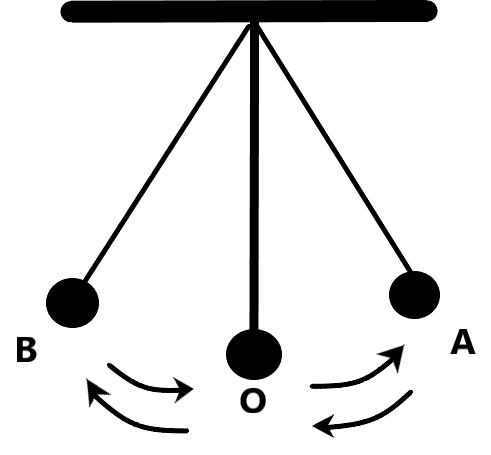
How are the time period T and the frequency f of a simple pendulum related to each other?
Answer
556.5k+ views
Hint: The relation between the frequency and the time period can be derived for any motion in a similar method. The time period and the frequency involved in the simple pendulum is related to each other in the same way as it is related in any other case.
Complete step-by-step solution
To know the relation between the frequency and the time period of a particular motion, we should initially know what the two parameters actually mean. Let us consider a simple pendulum, which undergoes a simple harmonic motion.
Let us define the two quantities initially. The time period is defined as the time taken by the pendulum bob to come back to its mean or equilibrium position after a complete to-and-fro oscillation. In the figure below, it is the time taken for the bob to start from O, then to A, then return to O, then move to B and return back to O. Its SI unit is seconds as it denotes a time.

The frequency is defined as the number of oscillations that the simple pendulum can undergo in a unit of time. Its SI unit is Hertz which is more clearly the inverse of a second. From the information, we understand that the frequency is the reciprocal of the time period.
i.e.,
\[f=\dfrac{1}{T}\]
This is the required relationship between the time period T and the frequency f in a simple pendulum.
Note: We know that the quantities time period T and the frequency f in a simple harmonic motion remains constant. In the case of a simple pendulum, the time period and the frequency are dependent on the length of the pendulum string or the mass of the system.
Complete step-by-step solution
To know the relation between the frequency and the time period of a particular motion, we should initially know what the two parameters actually mean. Let us consider a simple pendulum, which undergoes a simple harmonic motion.
Let us define the two quantities initially. The time period is defined as the time taken by the pendulum bob to come back to its mean or equilibrium position after a complete to-and-fro oscillation. In the figure below, it is the time taken for the bob to start from O, then to A, then return to O, then move to B and return back to O. Its SI unit is seconds as it denotes a time.

The frequency is defined as the number of oscillations that the simple pendulum can undergo in a unit of time. Its SI unit is Hertz which is more clearly the inverse of a second. From the information, we understand that the frequency is the reciprocal of the time period.
i.e.,
\[f=\dfrac{1}{T}\]
This is the required relationship between the time period T and the frequency f in a simple pendulum.
Note: We know that the quantities time period T and the frequency f in a simple harmonic motion remains constant. In the case of a simple pendulum, the time period and the frequency are dependent on the length of the pendulum string or the mass of the system.
Recently Updated Pages
Master Class 11 Business Studies: Engaging Questions & Answers for Success

Master Class 11 Computer Science: Engaging Questions & Answers for Success

Master Class 11 Maths: Engaging Questions & Answers for Success

Master Class 11 Chemistry: Engaging Questions & Answers for Success

Master Class 11 Economics: Engaging Questions & Answers for Success

Master Class 11 Accountancy: Engaging Questions & Answers for Success

Trending doubts
What is meant by exothermic and endothermic reactions class 11 chemistry CBSE

10 examples of friction in our daily life

One Metric ton is equal to kg A 10000 B 1000 C 100 class 11 physics CBSE

1 Quintal is equal to a 110 kg b 10 kg c 100kg d 1000 class 11 physics CBSE

Difference Between Prokaryotic Cells and Eukaryotic Cells

What are Quantum numbers Explain the quantum number class 11 chemistry CBSE




